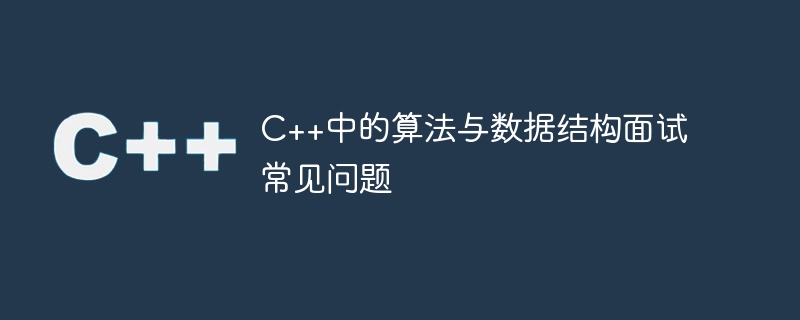

Algorithm and data structure interview questions in C
As a widely used programming language, its algorithm and data structure applications have also been Very high regard. In interviews, it is important to master the application of C algorithms and data structures. The following is an introduction to common C algorithm and data structure interview questions.
1. Algorithm
1. Sorting algorithm
The sorting algorithm is one of the most basic algorithms in C interviews. Commonly used sorting algorithms include bubble sort, insertion sort, selection sort, merge sort, quick sort, etc. Interviewers usually ask about the time complexity and space complexity of these algorithms, and ask candidates to write handwritten code to implement one of the sorting algorithms.
2. Search algorithm
There are two main search algorithms: sequential search and binary search. Interviewers usually ask about the time complexity and implementation methods of these two search algorithms, and require candidates to write handwritten code to implement one of the search algorithms.
3. Recursive algorithm
Recursive algorithm is widely used in C. The interviewer usually asks about the implementation method and application scenarios of the recursive algorithm, and requires the candidate to write handwritten code to implement the recursive algorithm.
4. Dynamic programming algorithm
The dynamic programming algorithm is an algorithm that decomposes the original problem into smaller sub-problems to solve. In C, dynamic programming algorithms are mainly used to solve optimal solutions and path problems. Interviewers usually ask about the basic principles and details of dynamic programming algorithms, and require candidates to write handwritten code to implement dynamic programming algorithms.
2. Data structure
1. Array
Array is a commonly used data structure and is widely used. In C interviews, interviewers usually ask about the basic operations, time complexity and efficiency of arrays, and require candidates to write handwritten code to implement add, delete, modify, and check operations on arrays.
2. Linked list
Linked list is a dynamic data structure with a wide range of uses. In the C interview, the interviewer usually asks about the basic structure, operation method and time complexity of the linked list, and requires the applicant to write handwritten code to implement the addition, deletion, modification and search operations of the linked list.
3. Stack and Queue
Stack and queue are also commonly used data structures in C. Interviewers usually ask about the basic structure, operation methods, time complexity and efficiency of stacks and queues, and require candidates to write handwritten code to implement stack and queue operations.
4. Tree
Tree is a logical structure with a wide range of applications, such as binary trees, red-black trees, Huffman trees, etc. In the C interview, the interviewer usually asks about the basic structure, operation method, time complexity and efficiency of the tree, and requires the candidate to write handwritten code to implement basic operations such as tree creation, traversal, insertion, and deletion.
The above is an introduction to common questions in C algorithm and data structure interviews. Interviewers need to master these basic knowledge points and use them flexibly during the interview. At the same time, you should practice more and think more in practical applications, strengthen your understanding and mastery of algorithms and data structures, and improve your algorithm programming abilities.
The above is the detailed content of Common interview questions about algorithms and data structures in C++. For more information, please follow other related articles on the PHP Chinese website!
 Page replacement algorithm
Page replacement algorithm
 Usage of treenode
Usage of treenode
 What are the differences between c++ and c language
What are the differences between c++ and c language
 Recommended learning order for c++ and python
Recommended learning order for c++ and python
 Cost-effectiveness analysis of learning python and c++
Cost-effectiveness analysis of learning python and c++
 Is c language the same as c++?
Is c language the same as c++?
 Which is better to learn first, c language or c++?
Which is better to learn first, c language or c++?
 The difference and connection between c language and c++
The difference and connection between c language and c++




